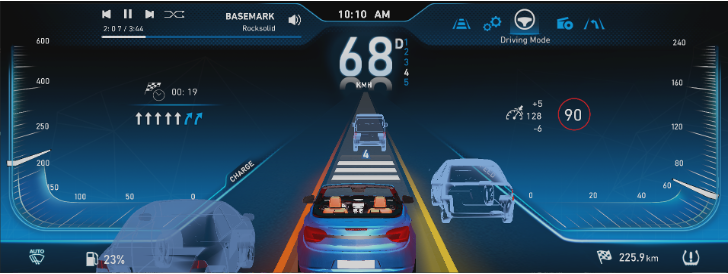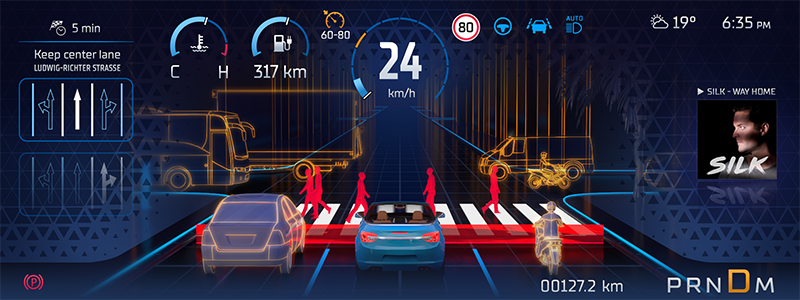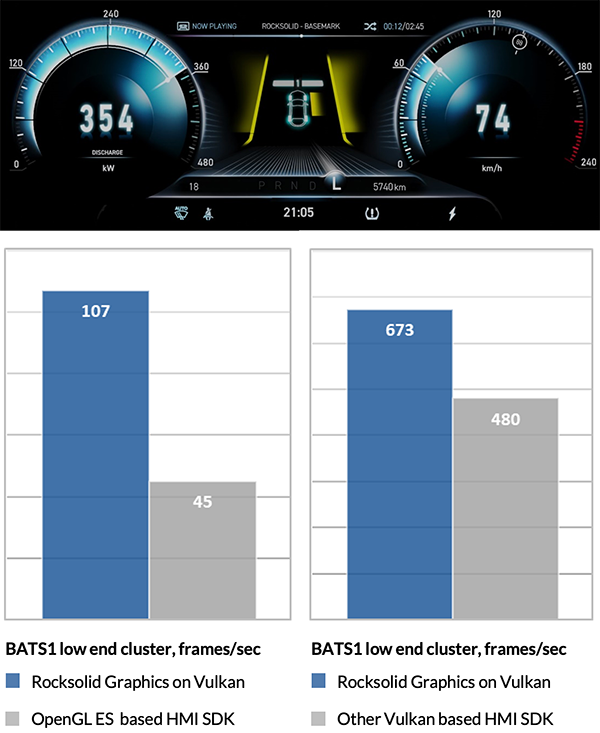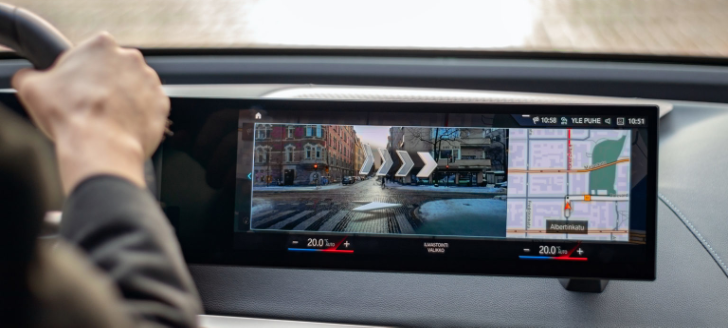
A shift in consumer interest is on the rise as consumers seek extraordinary in-vehicle features and user experiences instead of solely looking at the horsepower or engine of the car.
Emerging automotive trends like CASE (connected, autonomous, shared & electrical vehicles) force OEMs and tier suppliers to reinvent the car, which will have a major impact on the driver experience. The way we drive and interact with cars is about to change drastically. The human machine interface (HMI) between the driver and the vehicle is about to change as next generation automotive HMIs will make driving easier, safer, and more entertaining.
What is an automotive human machine interface?
A human machine interface (HMI) is a user interface that connects a person to a machine, system, or device. More simply put, the HMI is usually the screen that lets you interact with a system such as the screen of your smartphone or the screen of your coffee machine.
Automotive HMI is a set of elements such as instrument cluster, in-vehicle infotainment (IVI), or heads-up displays (HUD) that allow the driver to interact with the vehicle through touch, gesture, or voice interactions.
The future of the connected car and the implications on the human machine interface
The concept “the connected car” isn’t really something new. You can already sync phones and different devices with your car. However, there are still a lot of untapped possibilities to explore when it comes to connected cars.
In “Five trends transforming the automotive industry” by PwC, they refer to two different concepts of the connected car – the way the car is connected with the outside world, and the connection to other cars and traffic infrastructure. It will soon become a standard for cars to be connected to the internet, many of the vehicle functionalities will be operatable via apps, and cars will be able to “talk” to each other, sharing important information of e.g. road conditions, traffic jams etc. Alongside the development of autonomous vehicles and the connected car, drivers will in the future be able to use the time in the car for personal activities, such as watching Netflix, working, or socializing. According to Infopulse, younger generations are no longer interested in speed and design. They want in-vehicle experiences that allow them to stay connected, entertained, and comfortable, all with minimal to no effort on their part.

As cars become more connected, automotive HMIs needs to be developed further to ensure great user experience. To create next generation automotive HMIs, modern HMI toolchains should be used, that are tailored to support the development of video AR, 3D graphics, advanced instrument clusters and HUDs. Next generation HMIs should be developed whilst ensuring superior graphics performance and rendering, efficient use of energy, and easy deployment on various hardware solutions.
Improved graphics performance to support 3D-graphics and advanced graphics
While the increasing demand for more modern-looking automotive HMIs and improved functionality is evident, graphics engines must be compatible to render more comprehensive graphics. Gaming quality 3D-graphics is something consumers expect to have in their cars in the future. Therefore, it’s important to use the right design tools that let you create more extensive AR and 3D designs. Also utilizing the modern graphics APIs, such as Vulkan, will enable high-quality and high-performance graphics rendering on automotive SoCs.
Quick testing and deployment on hardware
Visualizing and creating HMI concepts based on emerging trends is only one part of the development process. Testing & iteration is yet another crucial part of the process. It is important to have an easy way to test and simulate concepts in an environment that is as close to the real environment as possible -and on actual hardware. By doing so, you can validate and test concepts quickly, creating a fast turnaround from concept to demo prototyping while comparing the performance on different hardware.
Optimizing usage of hardware
Efficient use of hardware is critical. The highly optimized graphics rendering engine will have a significant impact on the car’s total power usage. The more optimized the engine is – the less power it will consume. In modern electrical vehicles, every watt that can be saved on HMI increases the driving range.
Rocksolid Graphics for next generation automotive HMIs
The Rocksolid Graphics toolchain has been developed to tackle the challenges of creating next generation human machine interface’s. With an easy-to-use design & deployment workflow for 3D graphics and video AR applications, HMI features, and superior graphics performance – Rocksolid Graphics is the tool for developing next generation HMIs.
Vulkan - the enabler of efficient game quality graphics for HMIs
Rocksolid Graphics utilizes the Rocksolid Engine which is a powerful automotive graphics engine. Rocksolid Engine utilizes optimally Vulkan API, which allows for high-performance 3D graphics applications that work on all leading SoCs.
What makes Rocksolid Graphics unique compared to other automotive HMIs toolchains is its powerful performance and efficient use of the SoC. Benchmarking tests show that Rocksolid Graphics is 138% faster than OpenGL ES-based HMIs development kits when comparing performance on an entry-level digital cluster implementation.
Basemark has long experience in developing engines on top of Vulkan API. Our tests also show that Rocksolid Graphics is 40% faster when compared to another Vulkan-based HMI SDK with Samsung Exynos on Andriod. The performance difference is significant.
Rocksolid Graphics removes the complexity of Vulkan and enables HMI development teams to easily create high-performance applications to be rendered by using Vulkan, or OpenGL ES. This allows for deployment of applications on a wide variety of different processors.

The Rocksolid Graphics Toolchain
The Rocksolid graphics toolchain is set of tools enabling the creation of automotive human machine interface applications, including;
- Instrument clusters
- VideoAR navigation
- VideoAR clusters
- Heads-up display systems
- And more


To make the creation and implementation of applications as simple as possible, the toolchain also includes examples and a set of reference implementations, such as;
- How to get started with Rocksolid Graphics
- How to create VideoAR visualization
- How to create a digital cluster instrument
- How to deploy to target hardware
… and we are adding more reference implementations all the time.
And there is more! All reference implementations include code assets, documentation, and step-by-step videos on how to implement them.
